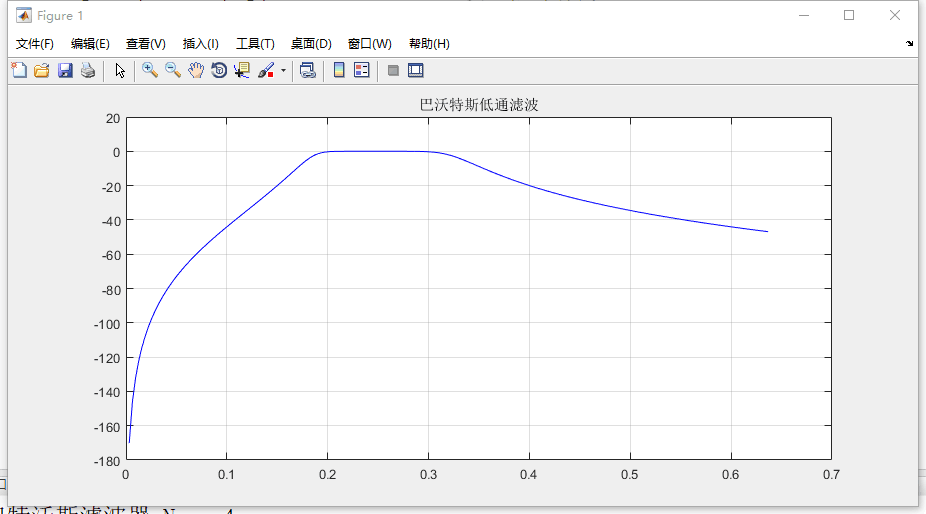巴特沃斯滤波
function [order,wn] = buttord(wp,ws,rp,rs,opt) %BUTTORD Butterworth filter order selection. % [N, Wn] = BUTTORD(Wp, Ws, Rp, Rs) returns the order N of the lowest % order digital Butterworth filter which has a passband ripple of no more % than Rp dB and a stopband attenuation of at least Rs dB. Wp and Ws are % the passband and stopband edge frequencies, normalized from 0 to 1 % (where 1 corresponds to pi radians/sample). For example, % Lowpass: Wp = .1, Ws = .2 % Highpass: Wp = .2, Ws = .1 % Bandpass: Wp = [.2 .7], Ws = [.1 .8] % Bandstop: Wp = [.1 .8], Ws = [.2 .7] % BUTTORD also returns Wn, the Butterworth natural frequency (or, % the "3 dB frequency") to use with BUTTER to achieve the specifications. % % [N, Wn] = BUTTORD(Wp, Ws, Rp, Rs, 's') does the computation for an % analog filter, in which case Wp and Ws are in radians/second. % % When Rp is chosen as 3 dB, the Wn in BUTTER is equal to Wp in BUTTORD. % % % Example 1: % % For data sampled at 1000 Hz, design a lowpass filter with less than % % 3 dB of ripple in the passband, defined from 0 to 40 Hz, and at % % least 60 dB of attenuation in the stopband, defined from 150 Hz % % to the Nyquist frequency (500 Hz). % % Wp = 40/500; Ws = 150/500; % [n,Wn] = buttord(Wp,Ws,3,60); % Gives minimum order of filter % [z,p,k] = butter(n,Wn); % Butterworth filter design % SOS = zp2sos(z,p,k); % Converts to second order sections % freqz(SOS,1024,1000); % Plots the frequency response % % % Example 2: % % For data sampled at 1000 Hz, design a bandpass filter with passband % % of 60 Hz to 200 Hz, with less than 3 dB of ripple in the passband, % % and 40 dB attenuation in the stopbands that are 50 Hz wide on both % % sides of the passband. % % Wp = [60 200]/500; Ws = [50 250]/500; % Normalizing frequency % Rp = 3; Rs = 40; % [n,Wn] = buttord(Wp,Ws,Rp,Rs); % Gives minimum order of filter % [z,p,k] = butter(n,Wn); % Butterworth filter design % SOS = zp2sos(z,p,k); % Converts to second order sections % freqz(SOS,1024,1000) % Plots the frequency response % % See also BUTTER, CHEB1ORD, CHEB2ORD, ELLIPORD, DESIGNFILT. % Copyright 1988-2015 The MathWorks, Inc. % Reference(s): % [1] Rabiner and Gold, p 241. narginchk(4,5); nargoutchk(0,2); % Cast to enforce precision rules wp = signal.internal.sigcasttofloat(wp,'double','buttord','Wp',... 'allownumeric'); ws = signal.internal.sigcasttofloat(ws,'double','buttord','Ws',... 'allownumeric'); rp = signal.internal.sigcasttofloat(rp,'double','buttord','Rp',... 'allownumeric'); rs = signal.internal.sigcasttofloat(rs,'double','buttord','Rs',... 'allownumeric'); if nargin == 4 opt = 'z'; elseif nargin == 5 if ~strcmp(opt,'z') && ~strcmp(opt,'s') error(message('signal:buttord:InvalidParam')); end end [msg,msgobj]=freqchk(wp,ws,opt); if ~isempty(msg), error(msgobj); end ftype = 2*(length(wp) - 1); if wp(1) < ws(1) ftype = ftype + 1; % low (1) or reject (3) else ftype = ftype + 2; % high (2) or pass (4) end % first, prewarp frequencies from digital (unit circle) to analog (imag. axis): if strcmp(opt,'z') % digital WP=tan(pi*wp/2); WS=tan(pi*ws/2); else % don't have to if analog already WP=wp; WS=ws; end %note - on old systems that are NOT case sensitive, this will still work OK % next, transform to low pass prototype with passband edge of 1 and stopband % edges determined by the following: (see Rabiner and Gold, p.258) if ftype == 1 % low WA=WS/WP; elseif ftype == 2 % high WA=WP/WS; elseif ftype == 3 % stop fo = optimset('display','none'); wp1 = lclfminbnd('bscost',WP(1),WS(1)-1e-12,fo,1,WP,WS,rs,rp,'butter'); WP(1) = wp1; wp2 = lclfminbnd('bscost',WS(2)+1e-12,WP(2),fo,2,WP,WS,rs,rp,'butter'); WP(2) = wp2; WA=(WS*(WP(1)-WP(2)))./(WS.^2 - WP(1)*WP(2)); elseif ftype == 4 % pass WA=(WS.^2 - WP(1)*WP(2))./(WS*(WP(1)-WP(2))); end % find the minimum order b'worth filter to meet the more demanding spec: WA=min(abs(WA)); order = ceil( log10( (10 .^ (0.1*abs(rs)) - 1)./ ... (10 .^ (0.1*abs(rp)) - 1) ) / (2*log10(WA)) ); % next find the butterworth natural frequency W0 (or, the "3dB frequency") % to give exactly rs dB at WA. W0 will be between 1 and WA: W0 = WA / ( (10^(.1*abs(rs)) - 1)^(1/(2*(abs(order))))); % now convert this frequency back from lowpass prototype % to the original analog filter: if ftype == 1 % low WN=W0*WP; elseif ftype == 2 % high WN=WP/W0; elseif ftype == 3 % stop WN(1) = ( (WP(2)-WP(1)) + sqrt((WP(2)-WP(1))^2 + ... 4*W0.^2*WP(1)*WP(2)))./(2*W0); WN(2) = ( (WP(2)-WP(1)) - sqrt((WP(2)-WP(1))^2 + ... 4*W0.^2*WP(1)*WP(2)))./(2*W0); WN=sort(abs(WN)); elseif ftype == 4 % pass W0=[-W0 W0]; % need both left and right 3dB frequencies WN= -W0*(WP(2)-WP(1))/2 + sqrt( W0.^2/4*(WP(2)-WP(1))^2 + WP(1)*WP(2) ); WN=sort(abs(WN)); end % finally, transform frequencies from analog to digital if necessary: if strcmp(opt,'z') % digital wn=(2/pi)*atan(WN); % bilinear transform else wn=WN; end
